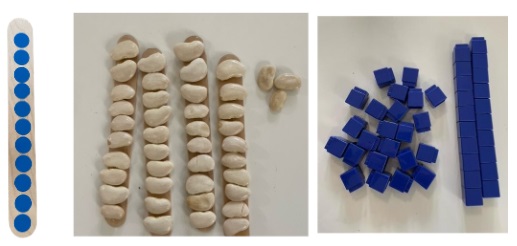When should I introduce base 10 blocks?
Oct 27, 2022
I often begin a PD by asking teachers to share an object or teaching resource that pops into their mind when they think of ‘place value’. Nearly always the first answer is base ten blocks (sometimes known as Multi-Attribute Blocks MAB, or Dienes blocks).
Now don’t get me wrong, I love base ten blocks and always recommend they be used when we are working on the Make/Represent aspect of place value (click here to learn about my 6 aspects of place value). But a question I am often asked is “when should I be introducing base 10 blocks to my students?”. My answer is always “it depends”, and I will explain why in this blog.
We all know the importance of using manipulatives to support students in maths. The widely used CRA instructional sequence (Concrete, Representational, Abstract) based on the work of Bruner and Kenney (1965) suggests that when we introduce a concept we should support students to develop their understanding by providing a concrete model (e.g., base ten blocks) before we move onto representations (e.g., drawing sticks to represent tens, dots to represent one), and finally abstract representations (numbers and symbols). There is also strong research to suggest the importance of helping students to visualise maths…but more on that another day! The CRA sequence allows students to be taken on an incremental journey to develop their understanding. You can read a little more about CRA in this short article.
In many areas of maths, CRA is a relatively ‘simple’ model to follow, but in place value, it is important to note that not all concrete models are created equally, therefore there are further considerations.
In this blog, I want to explore some of materials we can use in place value and when we should be introducing them. Some schools I've worked with have spoken of enforcing ‘blanket rules’ such as ‘base ten blocks can’t be used until Year 3’. I want to share the research I believe this advice has stemmed from, and hopefully clear up this confusion.
In 1990 Arthur Baroody wrote an excellent article titled “When and how should place value concepts and skills be taught?” In this research paper Arthur presents four increasingly abstract models of place value.
- Grouping ten ones into a ten
- Trading n Ten ones for a pre-grouped ten
- Trading in ten ones for a different looking ten marker
- Trading in ten ones for an identical marker that represents ten by virtue of its position
Baroody (1990)
I believe these are of immense importance when we are considering which manipulatives to use with our students. Let’s unpack the first two a little further:
Grouping tens ones into a ten
Manipulatives that allow students to physically count and place 10 objects themselves into a group is an important starting point. So examples of this are when you provide a collection of counters and students are asked to group them into tens, or having icy-pole sticks, counting 10 and then securing them with an elastic band, unifix blocks or sticking lima beans onto icy-pole sticks or tongue depressors, or my current favourite, sticking 10 circle stickers onto giant icy-pole sticks.

The important thing to focus on here, is the count of ten and the grouping which allows students to see the 10 ones ‘reimagined’ as a composite unit of 1 ten. Once we have created these groups, I do lots of counting with students, 1 ten, 2 ten, 3 tens… note when I am working with these manipulatives I am not yet focusing on counting by decades (ten, twenty, thirty) but in composite units (1 ten, 2 ten…). I am reinforcing that one ten is the same as 10 ones.
Trading in Ten Ones for a pre-grouped ten
Manipulatives that are ‘pre-grouped’ are a step up in abstraction for students. This is because the students are not involved in the physical act of grouping. These manipulatives (and by association, us as the teachers) assume the students have internalised why we are grouping in tens, which is actually a VERY tricky concept that takes a long time to master.
An example of a pre-grouped ten is the good old base ten blocks. As I said, I have nothing against these, BUT it is critical they are ONLY used when students are developmentally READY. How do we know they are developmentally ready? One way is by making sure they have lots and lots of experiences with many different manipulatives where they have grouped the ten themselves (see above).
By now you may be seeing where the ‘no base 10 until grade 3’ rule may have started. In my opinion, it came about because well-meaning teachers heard the idea that working with a ‘pre-grouped’ ten can be challenging for students. Which absolutely it is… but this is not the case for every student. Some students will only require a few experiences with grouping in tens and then will easily see the connection with pre-grouped tens. Others will take a LOT more experiences to internalize this idea. Either way, it is up to us to use our teacher knowledge and experience to determine who is ready for base 10. Therefore, I hereby advise schools to not provide “blanket rules” for base 10, but to empower teachers with the knowledge to use their own professional judgment on a case by case basis. If they identify some students in their first year of school class who are blitzing all the grouping in tens manipulatives, by all means give base 10 a go. Similarly if you are teaching a Year 3 and place value seems to just not be ‘sticking’, get your stickers and icy pole sticks out, and go back and allow the student multiple experiences of grouping in tens.
In next week’s blog I am going to address Baroody’s next two categorizations of manipulatives.
P.S: Did you know my Numeracy Teachers Academy is currently open for enrolments! I have a limited number of places left! So, if you want to learn from me over the next 12 months, click here.


